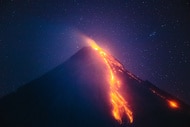Create a free profile to get unlimited access to exclusive videos, sweepstakes, and more!
NASA’s New Mars Map Leads to Icy Martian Treasures
On Mars, there's nothing more valuable than water.
It’s difficult to imagine the amount of advanced planning required for an interstellar mission. Before the crew of The Ark (streaming now on Peacock) could set out for parts unknown, they would first need to make those parts known. In the real world, we’re far from ready to visit another star system, but we are in the planning phase for our first interplanetary missions to Mars.
Getting there will require technological innovation, incredible bravery, and a bit of luck, but we can make the mission a little bit easier by finding the best places for Martian astronauts to go. Mars doesn’t offer much in the way of amenities, but it does have water reserves which will be invaluable to the astronauts who finally set food on the Red Planet. With that in mind, NASA has produced a new map outlining everywhere they might find water ice hidden beneath the Martian dirt.
Mapping Mars' Underground Water Ice
We’ve known for some time that Mars has at least some water preserved in the form of ice, scattered across its surface. Most of that ice, however, is concentrated at the poles where it's especially difficult to get hold of. While no parts of Mars are particularly comfortable, some are even less comfortable than others. The polar regions on Mars, much like on Earth, are especially frigid and not the sort of place we’re likely to send astronauts anytime soon.
RELATED: Astrobiologist Suggests We May Have Found and Killed Martian Life 50 Years Ago
“If you send humans to Mars, you want to get them as close to the equator as you can. The less energy you have to expend on keeping astronauts and their supporting equipment warm, the more you have for other things they’ll need,” said Sydney Do, JPL’s SWIM project manager, in a statement.
The SWIM project, short for Subsurface Water Ice Mapping, uses data from a number of Mars-based spacecraft including the Mars Reconnaissance Orbiter (MRO), 2001 Mars Odyssey, and the Mars Global Surveyor, to build a map pointing to the most likely locations for subterranean ice.
In 2022, astronomers identified a recent impact crater 492 feet in diameter. The scoured Martian surface revealed the frozen water ice hidden beneath the rust-colored dirt. Scientists used the crater to gut check their mapping system with an objectively validated ice source. Having verified the system worked, they let it loose on the rest of the Red Planet and built a subterranean ice map of Mars.
RELATED: Radiation Could Limit Mars Mission to Four Years
Importantly, the project points to ice stores in the northern midlatitudes where the thin Martian atmosphere is a little bit thicker, making it ideal for slowing down incoming spacecraft. Assuming the new maps are accurate, Martian astronauts could have access to a ready supply of frozen water, reducing the amount they would have to take with them. In fact, Martian water could be used in a number of ways including melting it for drinking water and splitting it into hydrogen and oxygen for breathing air and rocket fuel.
If you’re going to be the first person to walk on an alien world or fly to another star, it’s nice to have at least some idea of where you’re going.
Catch the complete first season of The Ark, streaming now on Peacock!























